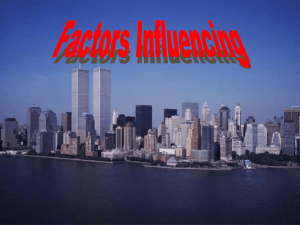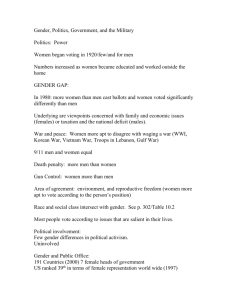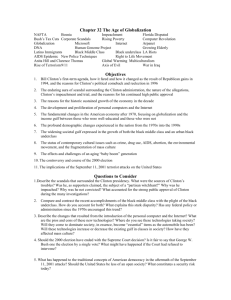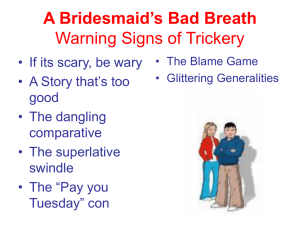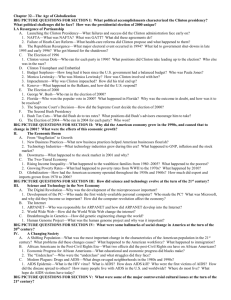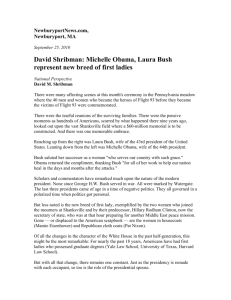Americans faced the twenty
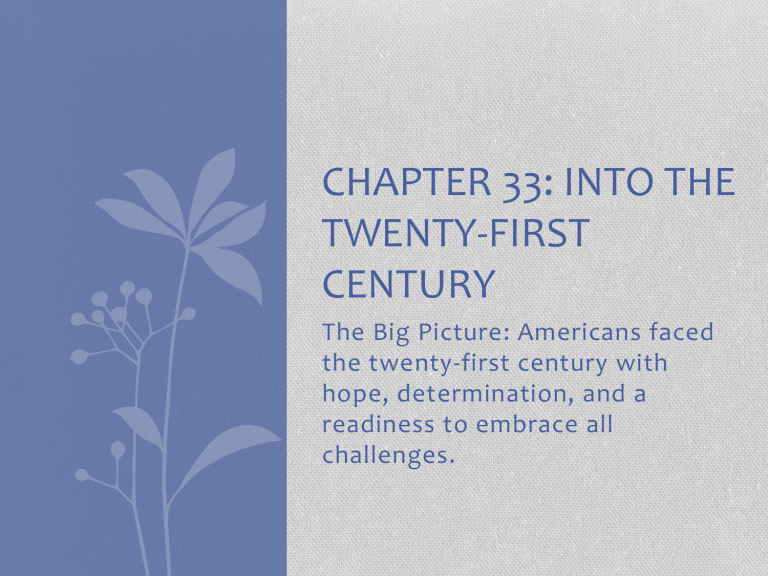
CHAPTER 33: INTO THE
TWENTY-FIRST
CENTURY
The Big Picture: Americans faced the twenty-first century with hope, determination, and a readiness to embrace all challenges.
CHAPTER 33 SECTION
1: THE CLINTON YEARS
Main Idea: Bill Clinton was a new type of Democrat, and his administration faced challenges for a new millennium– and scandals as old as politics.
Bill Clinton’s Political Rise
• Clinton was very successful as a politician, rising quickly in the Democratic Party
• Politically he was known as a New Democrat: not as conservative as most Republicans, not as liberal as many Democrats (also known as a centrist or moderate)
• Ran for the Democratic nomination for President in 1992
• Platform included a national health-care system and middle class tax cuts; campaign included his wife, Hillary Rodham Clinton
• Ran against George H.W. Bush as a defender of the middle class
• His campaign, and the inclusion of 3 rd party candidate Ross Perot
(who took Republican votes from Bush) led to Clinton’s election even though he won less than 50% of the vote
Domestic Policy Issues
Deficit Reduction
• Clinton was unable to fulfill his campaign promise to cut taxes, citing budget deficits, instead, taxes went up
• Republicans predicted that tax increases would harm the economy, but they were wrong
• Through-out the 90s, the US experienced a time of prosperity with low unemployment and low interest rates
Health-care Reform
• Health-care costs were rising and millions of Americans had no health insurance
• Hillary Clinton headed a task force to study the problem and offer possible solutions
• The major recommendation of the task force was government-sponsored healthcare
• After months of debate, the plan was defeated
Domestic Policy Issues
1994 Elections
• Defeat of the health-care plan reflected discontent with Clinton’s leadership
• He failed to deliver on several campaign promises and the tax increases were unpopular
• In mid-term elections, Republicans capitalized on public discontent
• Newt Gingrich and other
Republicans campaigned with the
Contract with America- a plan to balance the budget, fight crime, and cut taxes
• The plan was popular and
Republicans gained 62 seats in
Congress
• They controlled both houses of
Congress for the 1 st time in 40 years
Welfare Reform and other challenges
• Clinton bounced back from this defeat by focusing on issues the Republicans raised
• 1996- Clinton reforms the welfare program by limiting the amount of time people could collect benefits and required recipients to find work within two years of collecting benefits
• Internet emerges as a means of communication and commerce
• Congress tries to limit inappropriate material on the Internet, but were blocked by the Supreme Court in Reno v. ACLU
• Federal building in Oklahoma City is bombed (domestic terrorism) in 1995 killing
168
• Terry Nichols and Timothy McVeigh convicted of the crime
Foreign Policy Issues
Early Success in the Middle East
• US struggled to know their place in a post-Cold War world
• 1993 Clinton helped Israel (Rabin) and Palestine (Arafat) sign the
Oslo Accords (Palestine got self rule and Palestine recognized
Israel's right to exist)
• When Rabin was assassinated in
1995, the relationship between the two nations soured
Somalia and Haiti
• US had UN troops in Somalia to distribute food to victims of a civil war
• 1993- US troops began working to try to end the civil war
• October 1993 18 killed and 84 wounded in Mogadishu
• Clinton pulls out troops and decides not to get involved when genocide breaks out in Rwanda in
1994
• 1994 UN intervenes to remove a military dictator from Haiti
• US helps achieve a peaceful change in government
Foreign Policy Issues
The Former Yugoslavia
• Yugoslavia was formed after World War I and had several ethic groups that were enemies in the same country
• Each of these groups wanted their independence but the nation was held together by Josip Tito until his death in
1980
• After his death, the country fell apart and by the 1990s the small nations were fighting each other
• 1995 Dayton Accords: attempted to end fighting in Bosnia and Herzegovina
• 1999- urged the UN to stop Serbia from expelling Albanians from the Serbian region of Kosovo
• Bombing campaigns forced Serbian troops out
Promoting International Trade
• Clinton worked to get Congressional approval of NAFTA (North American
Free Trade Agreement)
• This treaty would eliminate tariffs from all goods going to and from
Canada, the US, and Mexico
• Many worried it would lead to job
losses in the US because wages were lower in Mexico
• Others countered that it would increase trade and help the economy
• Clinton also helped create the World
Trade Organization(WTO) that replaced GATT and helped settle trade disputes and create rules for global trade
Scandal and Impeachment
• Clinton wins re-election in 1996
• During 1 st term, Clinton and his wife were investigated in connection to a failed real estate project in the 1970s known as Whitewater
• The Clintons were accused of improperly getting and using loans for the project
• Special Prosecutor Kenneth Starr never charged the Clintons, but 3 of their business associates were found guilty of crimes
• Clinton also faced a sexual harassment case brought by Paula Jones from his time as governor
• Information emerged that he may have also had an inappropriate relationship with an intern named Monica Lewinsky
• Nov 1998- House of Representatives impeaches Clinton for perjury (lying under oath) and obstruction of justice (trying to cover up wrong doing)
• Early 1999, Senate votes to acquit Clinton, he is not removed from office
CHAPTER 33 SECTION
2: GEORGE W. BUSH’S
PRESIDENCY
Main Idea: Following a troubled election, Republican George W.
Bush won the White House and strongly promoted his agenda.
The Election of 2000
The Nominees
• The American economy prospered under Clinton (gov’t had a budget surplus)
• VP Al Gore wanted to be associate with that part of the Clinton administration, but not his scandalous image
• He picks Joe Liberman as his running mate (first Jewish man to run for the office)
• Republicans choose George W.
Bush, son of former President
Bush and governor of Texas
A troubled election
• Polls indicated that the race would be close; both popular vote and electoral college votes were very close on election night
• Election returns in Florida were so close that that the entire race hinged on the outcome there
• News organizations declared Gore the winner, then retracted and declared Bush the winner
• Finally they admitted it was too close to call over a month before a winner was announced
The Election of 2000
Recount and Legal Wrangling
• Because returns were so close,
Florida conducted a recount (Bush had a lead of only 300 out of 6 million ballots)
• Democrats were concerned about ballots that were not counted because they were not punched correctly…they wanted those ballots counted by hand
• One type of ballot, the butterfly ballot, was confusing for voters, causing concern that some voters voted incorrectly
• Lawsuits were filed by both
Republicans and Democrats over the recount
Bush v. Gore
• December- Florida Supreme Court declared there should be a manual
(by hand) recount…this favored
Gore
• Bush appeals to Supreme Court
• In Bush v. Gore the Supreme Court stops the manual recount (can’t change counting methods in the middle of an election); therefore
Bush won Florida and the 2000
Election
• Bush was the 4 th president in US history to win even though he lost the popular vote
Bush’s Domestic Policy
Economic Changes
• Economic prosperity of the 90s was waning
• Dot-com stocks began to fall and several major business had financial problems, leading to a stock market drop and recession
Tax Cuts
• Even though the economy was in recession, Bush still believed that tax cuts would help the nation
• Tax cuts did not help the economy improve
• The administration cut taxes again in 2003, but it did not help the economy then either
Bush’s Domestic Policy
Education, health care, and more
• 2001: No Child Left Behind- used annual testing to ensure students met academic standards
• Bush also encouraged federal funding to faith-based organizations
• 2003- Medicare updated to include prescription drug coverage
Bush’s Second Term
• 2004: Bush runs against John
Kerry, who is critical of Bush’s handling of the economy and foreign policy…Bush wins
• Bush focuses on Social Security reform
• Bush proposes moving social security funds into private retirement accounts rejected by
Congress
• Bush able to put two new conservative justices on the
Supreme Court: John Roberts and
Samuel Alito
Bush’s Foreign Policy
• Bush asks Gulf War general Colin Powell to be his Secretary of State and
Condeleezza Rice to be National Security Advisor
• After 2004 Election, Powell resigned and Rice took his place
• Donald Rumsfeld served as Secretary of Defense
• Bush refused to use troops for ‘nation building’ as Clinton had done
• Bush cancelled the 1972 Anti-Ballistic Missile Treaty but also reduced US nuclear arms
• The cancellation of the ABM Treaty caused friction with Russia and China
• He also tried to work on peace in the Middle East but was unsuccessful
CHAPTER 33 SECTION 3:
HOW SEPTEMBER 11,
2001, CHANGED
AMERICA
MAIN IDEA: A horrific attack on
September 11, 2001, awakened the nation to the threat of terrorism and changed America’s view of the world.
September 11, 2001
• 2 commercial planes crashed into the twin towers of the World Trade
Center; a 3 rd plane crashed into the Pentagon, and a 4 th crashed in a field in Pennsylvania
• Millions of Americans watched live as the twin towers collapsed
• Over 3,000 people were killed in the attacks
• The nation was overwhelmed with grief and anger and admired first responders like the NY Fire Department
• Millions donated blood and money to help the victims of the attacks
• Patriotism soared and America began a new war: the War on Terror
Background to the Attacks
• Federal investigators focused their attention on Osama bin Laden, a wealthy Saudi Arabian who had gone to Afghanistan in the 1980s to fight Soviet invaders
• He embraced radical Islam and wanted to destroy the US; he was also angry about US presence in the Middle East
• Bin Laden created a terrorist network called al Qaeda to carry out attacks around the world– they were responsible for an attack on the WTC in 1993 and embassies around the world
• The US tried to attack a training base in Afghanistan under Clinton, but bin Laden escaped and later attacked the USS Cole, killing 17
• al Qaeda operative began moving into the US and enrolling in flight school to prepare to take over planes for the attacks
The United States Responds
War in Afghanistan
• The Taliban controlled Afghanistan and implements strict Islamic law
• bin Laden support the Taliban and the Taliban aided bin Laden
• Bush put pressure on the Taliban to turn over bin Laden, but they refused
• Oct, 2001- US and GB attacks
Afghanistan
• They were able to quickly overthrow the Taliban, but did not find bin
Laden
• Afghanistan still faces instability as
American troops prepare to withdraw completely
Fighting Terrorism at Home
• To coordinate anti-terrorism efforts, Bush and Congress created the Department of Homeland
Security
• The US also faces the possibility of biological terrorism (anthrax is mailed to several government officials)
• Congress passes the USA Patriot
Act that made it easier for law enforcement to secretly collect information about suspected terrorists
• Some critics believe that it violates individual freedoms
War in Iraq
• After a successful war in Afghanistan, Bush vowed to fight terrorism in Iraq, claiming that Saddam had weapons of mass destruction
• UN weapons inspectors in 2003 found no evidence of weapons, but
Bush believed they had been hidden
• US invades Iraq March 2003
• By April Saddam Hussein’s government fell and the country descended into civil war
• No evidence of weapons of mass destruction were ever found
CHAPTER 33 SECTION
4: LOOKING AHEAD
MAIN IDEA: The dawn of a new century found the United States facing a new era of opportunity and challenge.
America’s Changing Face
Tomorrow’s population
• Minorities currently make up 30% of the US population
• By 2050, minorities are expected to make up 50% with Hispanics as the largest minority group
Regional Changes/Graying Population
• Sunbelt (South and West) growing faster than other regions of the US
• Lower energy and labor costs attract business to this region as well
• Americans are also getting older; people over 64 is the fastest growing group
• Caused mostly by the aging/retirement of baby boomers
• Will place a strain on Social
Security and Medicare
The Promise of Technology
Computers:
• 60% of Americans own computers (only 1% in 1980) most connected to the Internet
• Most appliances, cars, and electronics contain computer chips
• Information Technology is a major part of every industry
Agriculture:
• Genetic engineering is used to grow higher yield crops in less than ideal conditions but is controversial (is it safe?)
Exploration:
• Bush advocated building bases on the moon and Mars, but economic problems stalled these projects
Challenges for the Future
Health and health care
• life expectancy continues to grow and the US faces challenges with expensive chronic health problems (heart disease, diabetes, obesity)
• Cost of healthcare is a serious problem Affordable Healthcare Act: attempt to slow the rate of cost increase by helping/requiring all
Americans to have health insurance
Energy and the Environment
• America faces challenges in providing inexpensive energy without harming the environment
Rebuilding After Hurricane Katrina and Sandy
• Storm devastated Gulf states in August 2005; over 1,000 die
• Hurricane Sandy hits New Jersey October 2012
Causing billions of dollars of damage

